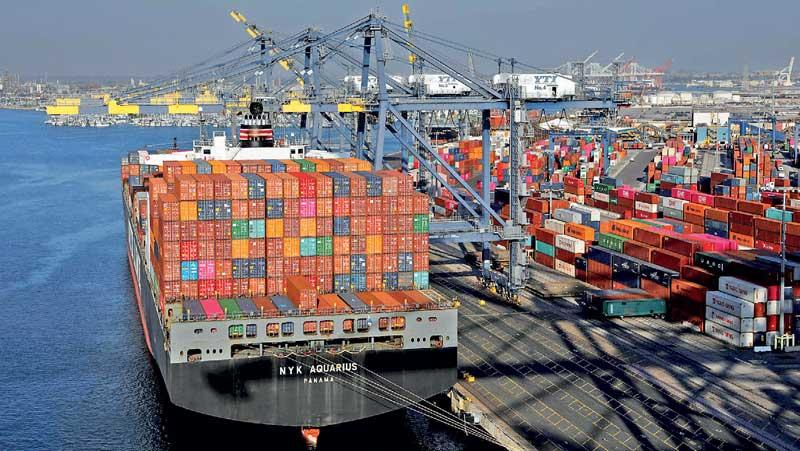13 Feb 2020 - {{hitsCtrl.values.hits}}

 Global Value Chain will continue to enhance economic growth, create better job opportunities, and shrink poverty in the developing countries to a greater extent.
Global Value Chain will continue to enhance economic growth, create better job opportunities, and shrink poverty in the developing countries to a greater extent.
As way back from 1990s, through international trade, Global Value Chain benefits were experienced by poorer countries and paved the path for their economic growth.
Fragmentation of production was the key methodology in the conception, where a production process could be broken down to many subsections and could take place across other neighbouring countries, in other words different companies specialize in specific tasks and do get involved in producing the final product.
In this process raw material with value addition may cross the border of a country and reach another country for value addition, as semi-finished goods and be assembled as a final product for consumption. It is vital to address required policy changes and enhancements by the authorities, in order to ensure continued participation in global
value chains.
Technological developments taking place globally, containerization and policy reforms are contributing immensely in reducing cost of trade. Integration of China, Eastern Europe, North American Free Trade Agreement (NAFTA), establishing the World Trade Organization in 1995 have contributed enormously to the development of international trade. This situation is providing greater opportunities for developing economies to be connected with industrial bases of developed economies, rather than trying to rebuild the entire industry
from scratch.
Through the concept of product fragmentation, firms operating in developing economies, have access to foreign markets with a lower cost, better productivity, improved management practices and providing higher paid better quality jobs, which would ensure a faster growth in the economy.
Trade growth and global value chain formation has not reached the maximum potential since financial crisis in 2008; the main reasons behind, could be trading partners such as Europe contributing one-fourth of global output and one third of global trade, and China the second largest economy in the world could provide a better contribution to the same.
There are many ways that countries participate in Global Value Chain, where Argentina, Ethiopia and Indonesia are engaged in simple manufacturing production chains but Algeria, Chile and Nigeria are engaged in exporting commodities and raw materials required for production processes.
It is noteworthy that India and the US are producing more and more services required by complex production processes elsewhere, almost half of the world trade considered to be taking place on Global Value Chain transactions.
Few regions, some sectors, and some large multinational firms are efficaciously engaged in Global Value Chain. East Asia, Europe and North America are providing good examples and account for very large production capacities, in electronic, machinery and transport equipment manufacturing, well fragmented across countries.
These firms contribute more than 80 percent to their total trade flows. The expansion of value chains is taking place both regionally and globally. Europe is considered to be most integrated region in this aspect. The North America situation is somewhat different having more global partnerships than regional. It is interesting to note that Value Chain partnership linkages are now becoming more global than regional.
Contributors to GVC development
With advance development took place in Information & Communication Technology the manufacturing firms found it easier to contract out and organize much more complex activities at a distance, whilst ensuring excellence of a product.
Lowering transport mainly declining air and sea freight costs also contributed positively to trade and Global Value Chain development. Reliability and Inexpensive cost of communication contributed vastly to the development of the services sector. Trade and Investment liberalization activities taking place in both developed and developing economies are having a positive impact on reducing barriers oftrade for goods and services.
Reducing non-tariff barriers arealso giving a boost to trade but the expectations of the business community is still high, and much more tobe done in this area. The facts such as creation of EU single market, China, India and Russia effectively integrating with global economy, created hugelabour and product markets. The firms were able to get the deep benefits of Global Value Chain and address economies of scale issues whilst relocating their factories in cheap labour markets, maximizeprofits and finding
better suppliers.
There are four different ways that countries participate in Global Value Chain, namely:
1. Commodity Producing,
2. Limited Manufacturing
3. Advanced Manufacturing and services
4. Innovative activities
As per the world bank report, Countries in the commodities group have a small share of manufacturing exports and limited backward Global Value Chain integration.Argentina, Armenia, Bosnia and Herzegovina, Cambodia, Costa Rica, Cyprus, El Salvador,Ethiopia, Indonesia, Kenya, Nepal, Serbia, South Africa had been in commodities and moved in to limited manufacturing in the recent past. Jordan and Lesotho downgraded their status from limited manufacturing to commodities.
Countries such as China, Estonia, India, Lithuania, Philippines, Poland, Portugal, Romania, Thailand and Turkey are in advanced manufacturing and services in Global Value chain Integration, having a high share of manufacturing and business services exports and with high backward Global Value Chain integration.
Countries like Austria, Canada, Finland, Ireland, Israel, Italy, Republic of Korea, Singapore, and Spain made their moves to innovative activities. Intellectual property receipts as a percentage of GDP, Research and development concentration as a percentage of GDP are the measuring instruments of innovative activities .
As regions East Asia, Europe, and North America are engaged in advanced manufacturing and services and innovative activities, whereas Africa, Central Asia, and Latin America are mostly in commodities and limited manufacturing.
Example of Vietnam
Today, Vietnam is providing one of the best examples for Global Value Chain integration. Being the second largest smart phone exporter, Samsung is producing 40 percent of their phones, and employing 35 percent (over 160,000) of their global staff engagement in Vietnam. Other global players such as, LG, Canon, Panasonic, Foxconn, Intel and Microsoft are also operating in Vietnam.
Geographical location of Vietnam which is an encouraging factor for Global Value Chain Integration, specially being close to China, Japan, and Korea who are electronic component and parts suppliers. Vietnam managed to attract Foreign Direct Investments (FDIs), and acquired much needed capital, technology and management skills. Improvements intransport and communication infrastructure and making the logisticsindustry competitive which leveraged it further.
Key policy level factors backing this developmentin Vietnam are, World Trade Organization’s Trade Facilitation Agreement , Agreement with United States, Being a member of ASEAN (Southeast Asian Nations) and having many free trade agreements, EU bilateral Trade Agreement, making a total of 16 trade agreements.
With this background Vietnam exports are more than 90% as a percentage of their GDP.
Bangladesh in GVC
Bangladesh can be considered as a very good example for the global value chain participation. Apparel and footwear exports of Bangladesh was approx. one percent of global demand by 1988. Since then the yearly growth they achieved was approx. 18 percent, and Bangladesh is the third largest exporter of apparel and footwear, having a 7 percent stake, China and Vietnam being the first and the second.
This sector is contributing 89 percent of their total exports and 14 percent of their GDP. Further this sector is engaging 3.6 million workers out of which 55 percent are women. In this background agriculture share of the GDP fell down to 38 percent by 2018, from 70 percent in 1988. The extreme poverty level also reduced from 44 percent to 15 percent in the said period.
Through Global Value Chain participation, local firms were able to share technology with their business partners effectively, it is no longer required to master the entire production of an item, through hyper-specialization, countries can produce one or few tasks of a final product, so that they could master a particular task with maximizing the productivity and technology usage. The facts have confirmed that within 3 years of Linking Global Value Chain, an economy has the capability to increase per capita basis by 20 percent and better quality jobs.
Increasing market size through liberalized trade policies
Domestic market size and limited local inputs are always a constrain for small countries, negotiating trade liberalizing agreements with other economies may bring in solution for this aspect.
Import and export regulatory measures such as tariffs, quotas may limit the country’s ability to be integrated with global Value Chain at large. Cross border activity efficiencies should be increased to the maximum level reducing the cost of Import and Export and time taken for such activities.
Cross Border Facilitation and National Single Window (NSW)
The National Single Window comes in to picture, in providing above mentioned facilities in a very methodical efficient manner. National Single Window, for foreign trade is a facility created using Information Technology and telecommunication platforms, initiated by a government to facilitate import, export and transit bureaucracies, by offering a single point for the submission of standardized information and documents, in order to fulfill official demands and facilitate logistics.
It handles all public and private administrative procedures in foreign trade. This single submission may be lodged through single window for reuse across a range of government agencies, by trader organizations and even by individuals. The basic principles of single window are built on this single submission of data; hence, it may be reused by the system wherever required without additional data entry.
Further, single window attributes include a single point of payment, improved business processes in government agencies, and speedier turn-around for approvals and decisions. It gives opportunity for traders and their agents to connect up with ministries of trade, agriculture, health, food security, and finance and so on to electronically lodge license applications and customs declarations.
It is a known fact that the information technology advancement and innovation has given great benefits to international trade development. Automated custom clearances, port operations, import and export authority requirements were able to complete much more effectively than before. In an increasingly globalized environment many economies needed a much more effective system than that automated customs operations from the 1980s namely, Asycuda.
Many Single Windows were implemented in the world and “Doing Business Index”, for the first time in the year 2017, went to the extent of measuring effectiveness of the single window systems, through Trading Across Borders. It is considered as a system that receives trade related information and disseminates to the government authorities and many private sector stake holders and individuals.
Taxation, challenging situation for GVC
Different tax systems existing in countries are creating challenging situation for Global Value Chain and product fragmentation, by adding up to cost of production making the final product uncompetitive in the market. So, the countries are under pressure to keep corporate tax levels at more competitive rate, and attract more and more Foreign Direct Investment and domestic investments, through Global Value Chain integration and fragmentation.
Lowering the cost of transportation and communication services as well as improving the quality of such services will have a positive impact on the economy. Many multi nationals take serious decisions to relocate their production facilities based on these theaspects. Policy consistency is also considered a sensitive factor for making business decisions.
Reference :World Bank Publications
(The contents of the article do not constitute any opinion of the institution/employer that the writer is connected to. Writer can be reached through [email protected])
16 Nov 2024 2 hours ago
16 Nov 2024 2 hours ago
16 Nov 2024 3 hours ago
16 Nov 2024 3 hours ago
16 Nov 2024 4 hours ago